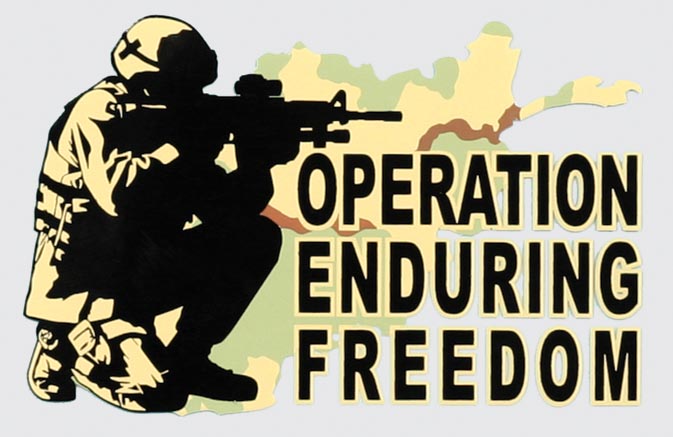

October 7th, 2001

Operation Enduring Freedom
After the September 11, 2001, attacks on the World Trade Center and the Pentagon, the United States military entered into a "War against global terrorism." The President began the US response in the War on Terrorism with the stroke of his pen to seize terrorists' financial assets and disrupt their fundraising network. Unlike most previous conflicts, this war was being fought on both domestic and foreign soil. Deployment of American troops to southwest Asia and countries surrounding Afghanistan came in the days following the attacks.
The military response to the 11 September 2001 terrorist attacks on the United States was assigned the name Operation Enduring Freedom, but was previously planned to have been called Operation Infinite Justice (this name was believed to have been changed following concerns that this might offend the Muslim community as Islam teaches that Allah is the only one who can provide Infinite Justice).

OEF commenced on 7 October 2001. Early combat operations included a mix of air strikes from land-based B-1, B-2 and B-52 bombers; carrier-based F-14 and F/A-18 fighters; and Tomahawk cruise missiles launched from both U.S. and British ships and submarines.


The initial military objectives of Operation Enduring Freedom, as articulated by President George W. Bush in his Sept. 20th Address to a Joint Session of Congress and his 7 October 2001 address to country, included the destruction of terrorist training camps and infrastructure within Afghanistan, the capture of al Qaeda leaders, and the cessation of terrorist activities in Afghanistan.
Secretary of Defense Donald Rumsfeld stated in an 7 October 2001 DoD News Briefing, that US objectives were to make clear to Taliban leaders that the harboring of terrorists was unacceptable, to acquire intelligence on al Qaeda and Taliban resources, to develop relations with groups opposed to the Taliban, to prevent the use of Afghanistan as a safe haven for terrorists, and to destroy the Taliban military allowing opposition forces to succeed in their struggle. Finally, military forces would help facilitate the delivering of humanitarian supplies to the Afghan people.
The British had also defined the goals of their involvement (termed Operation Veritas) in "Her Majesty's Government's Campaign Objectives," dated 16 October 2001. The short term goals of the military action included the capture of Osama bin Laden and other al Qaeda leaders, the prevention of further attacks by al Qaeda, the end of Afghanistan's harboring of terrorists, their training camps and infrastructure, and the removal of Mullah Omar and the Taliban Regime. Long term goals included the end of terrorism, the deterrence of state sponsorship of terrorism, and the reintigration of Afghanistan into the international community

On Sunday October 7, 2001, American and British forces began an aerial bombing campaign targeting Taliban forces and al-Qaeda.
The Northern Alliance, fighting against a Taliban weakened by U.S. bombing and massive defections, captured Mazari Sharif on November 9. It rapidly gained control of most of northern Afghanistan and took control of Kabul on November 13 after the Taliban unexpectedly fled the city. The Taliban were restricted to a smaller and smaller region, with Kunduz, the last Taliban-held city in the north, captured on November 26. Most of the Taliban fled to Pakistan.
The war continued in the south of the country, where the Taliban retreated to Kandahar. After Kandahar fell in December, remnants of the Taliban and al-Qaeda continued to mount resistance. Meanwhile, in November 2001 the U.S. military and its allied forces established their first ground base in Afghanistan to the south west of Kandahar, known as FOB Rhino.
The Battle of Tora Bora, involving U.S., British and Northern Alliance forces took place in December 2001 to further destroy the Taliban and suspected al-Qaeda in Afghanistan. In early March 2002 the United States military, along with allied Afghan military forces, conducted a large operation to destroy al-Qaeda in an operation code-named Operation Anaconda.
The operation was carried out by elements of the United States 10th Mountain Division, 101st Airborne Division, the U.S. special forces groups TF 11, TF Bowie, and TF Dagger, British Royal Marines, the Norwegian Forsvarets Spesialkommando (FSK), Hærens Jegerkommando and Marinejegerkommandoen, Canada's 3rd Battalion Princess Patricia's Canadian Light Infantry, the Afghan National Army, the German KSK, and elements of the Australian Special Air Service Regiment and of the New Zealand Special Air Service.
After managing to evade U.S. forces throughout the summer of 2002, the remnants of the Taliban gradually began to regain their confidence. A Canadian and U.S. led operation (supported by British and Dutch forces), Operation Mountain Thrust was launched in May 2006 to counter renewed Taliban insurgency.
Since January 2006, the NATO International Security Assistance Force undertook combat duties from Operation Enduring Freedom in southern Afghanistan, the NATO force chiefly made up of British, Canadian and Dutch forces (and some smaller contributions from Denmark, Romania and Estonia and air support from Norway as well as air and artillery support from the U.S.) (see the article Coalition combat operations in Afghanistan in 2006). The United States military also conducts military operations separate from NATO as part of Operation Enduring Freedom in other parts of Afghanistan, in areas such as Kandahar, Bagram, and Kabul (including Camp Eggers and Camp Phoenix.)








